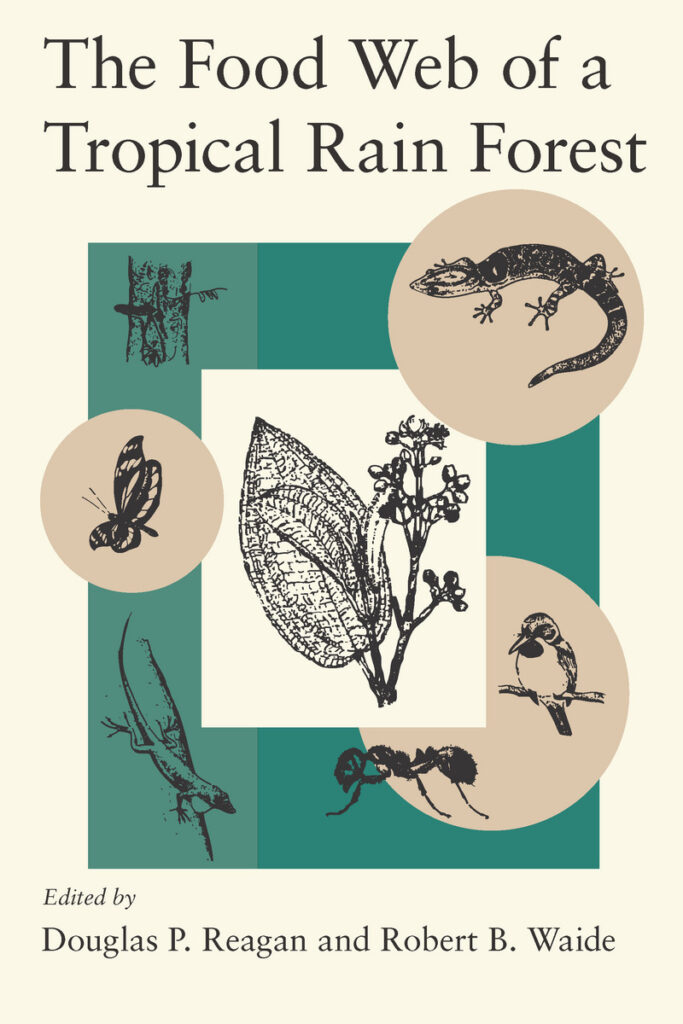By Robert B. Waide

Many research issues in ecology are related to the understanding of relationships between predator and prey. Knowledge of population dynamics, energy flow, nutrient cycling, primary productivity, ecosystem stability, and biodiversity all depend to greater or lesser degree on our understanding of feeding relationships. The construction of a food web provides a mechanism for summarizing all of the feeding relationships in a community. Since the food web is a map of the feeding interactions in a community, it provides a framework for understanding community organization and for comparing among communities.
A major research activity of the Luquillo LTER has been to document feeding relationships and develop a detailed food web describing these relationships. This work is summarized in “The Food Web of Tropical Rain Forest” (Reagan & Waide 1996). The existence of this body of work allows us to address questions concerning the relationship between productivity and biodiversity, the relative importance of top-down and bottom-up control of community structure, and the functional importance of redundancy in ecosystems. Moreover, work at Luquillo represents the first detailed description of the food web of a tropical forest and provides important insights into the structure of complex communities.
The animal community at El Verde exhibits several distinctive characteristics that affect the structure of its food web. The characteristics are a product of tropical location, disturbance regime, and spatial and temporal constraints related to island size, distance and history of isolation from continents. These characteristics include: Absence of large herbivores and predators; Low faunal richness compared to the tropical mainland; A superabundance of frogs and lizards; Discontinuities in the distribution of species at aquatic-terrestrial and litter-vegetation boundaries; Adaptations to frequent disturbance; Diurnal, seasonal, and successional heterogeneity in the activity of species
These distinctive characteristics of the animal community determine to a great extent the structure of the food web at El Verde. For purposes of analysis, the 2601 species of consumers were lumped into 156 “kinds of organisms”, representing species, stages in the life cycle within a species, or collections of functionally or taxonomically related species. Moreover, 214 species of plants occurring at El Verde were classified into 20 structural categories. Even when species were combined in this way, the resulting food web was much more diverse than most published food webs and more representative of actual food web functions. This situation, coupled with the abundance of ectothermic frogs and lizards, led to several conclusions that were at variance with conventional wisdom about food webs, to wit:
1. Feeding loops should be rare because they destabilize the system:
Feeding loops (in which species A eats B, B eats C, and C eats A) are common at El Verde. Some of these loops involve reciprocal predation among different life history stages of mutual predators. For example, Eleutherodactylus coqui (a common frog) eats juvenile centipedes, wolf spiders, tarantulas, and whip scorpions, all of which consume juvenile coqui as adults.
2. Community food webs have constant connectance:
The constant connectance hypothesis predicts that a species will have a fixed proportion (around 14%) of feeding links regardless of the number of species in the community. If species A is found on the mainland with 10,000 other species and on an island with 100 other species, it will interact with 1,400 species on the mainland and 14 on the island, give or take a few. At low resolution (when many species are lumped), connectance in the El Verde web fits the constant connectance hypothesis. However, as resolution increases, connectance is nearly 1/10 of that predicted by the constant connectance hypothesis.
3. Regardless of the number of species in the community, the ratio of basal to intermediate to top predators will not change:
In the El Verde web, the ratios change significantly as the web is more finely resolved. This result suggests that the observed constant ratios from other studies result from the fact that top predators are always identified to species while prey are often lumped into higher taxonomic categories
4. Omnivores are rare
An omnivore is a species that feeds at more than one trophic level. In the El Verde web, omnivory is pervasive, with some omnivores feeding at several trophic levels. A typical example is Anolis evermanni, a lizard, which consumes all but the smallest arthropods regardless of trophic level. Many species of birds, frogs, lizards, and large invertebrates feed on more than one trophic level.
5. Food webs within the same habitat are not divided into compartments
The most abundant consumers in the El Verde food web are anoline lizards, which are diurnal, and coqui frogs, which are nocturnal. Major anole predators (Puerto Rican lizard cuckoo, pearly-eyed thrasher, hawks) are also diurnal while most coqui predators (tarantulas, crab spiders, whip scorpions, Puerto Rican screech owl) are nocturnal. Thus, day-night activity differences lead to distinct subwebs (compartments) with the same habitat. If diets of coquis and anoles were compared using different levels of taxonomic resolution, overlap in diets decreased to 12% when prey were identified to species.
6. Food chains are short, usually containing three to five links
The El Verde web has a mean food chain length of 8.6 links, with a maximum of 19.
Some of the patterns that have emerged from work at El Verde may result from general characteristics of tropical ecosystems and hence should be observable in other tropical communities. For example, tropical breeding patterns maintain various life stages of many species throughout the annual cycle, providing the opportunity for feeding loops to be more prominent. The day-night separation of feeding interactions may also be a general pattern in species-rich tropical communities, where specialization is high. However, until more food webs are available in which feeding relationships are resolved to the species level, comparisons between El Verde and other tropical communities will be limited.
